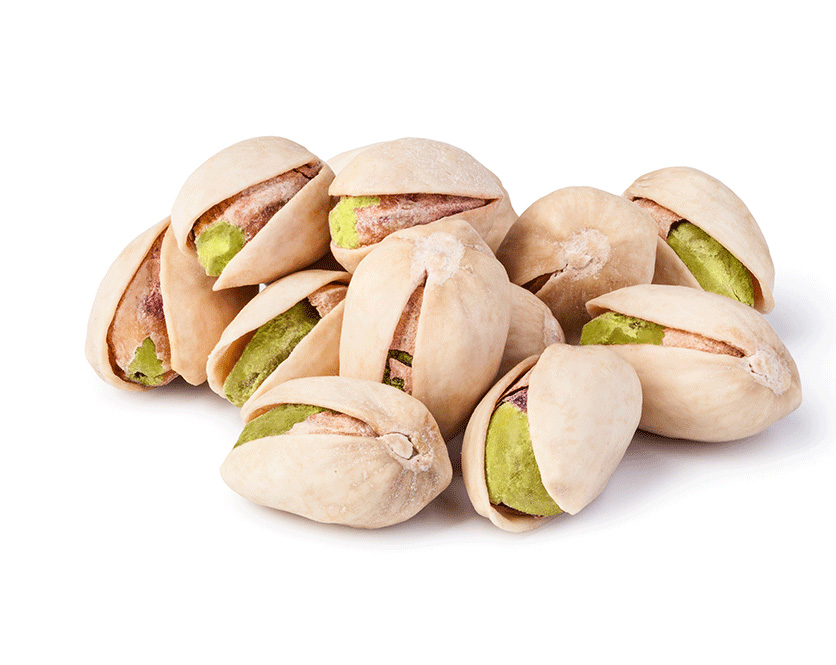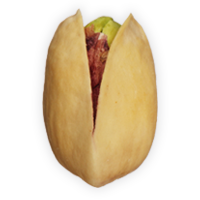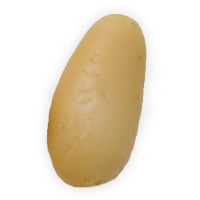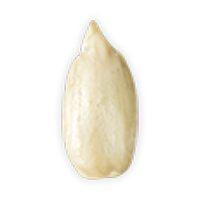OTHER NUTS
Other nuts
PISTACHIOS, PINE NUTS & SUNFLOWER KERNELS
The pistachio, a member of the cashew family, is a small tree originating from Central Asia and the Middle East. American botanist William E. Whitehouse brought pistachios to the U.S. in 1930 and planted the first test plots. However, pistachio trees take 7 to 10 years to mature, so it was almost a decade before he had his first success. The pistachio’s uniqueness is its green color. Used in desserts, ice cream and for snacking, they are quite a delicacy because of their rich, agreeable flavor.
Pine nuts are the hard-to-harvest seed of the umbrella-shaped stone pine tree, which has been cultivated for its nuts for over 6,000 years. This versatile, torpedo-shaped kernel has been used for centuries in a variety of international cuisines, especially Mediterranean. In fact, its sweet flavor and delicate crunch continues to be used as the basis for great pesto, breads and pastries, or to add body, texture and flavor to favorite sauces, entrées and salads.
Native to the Americas, sunflowers were cultivated for their seeds thousands of years ago in present-day Mexico, Arizona and New Mexico. Some archaeologists suggest that the sunflower may have been domesticated before corn. Sunflower kernels were ground into flour for cakes or breads, squeezed for their oil or cracked from their shells to enjoy as a snack.

Other nuts
PISTACHIOS, PINE NUTS & SUNFLOWER KERNELS
The pistachio, a member of the cashew family, is a small tree originating from Central Asia and the Middle East. American botanist William E. Whitehouse brought pistachios to the U.S. in 1930 and planted the first test plots. However, pistachio trees take 7 to 10 years to mature, so it was almost a decade before he had his first success. The pistachio’s uniqueness is its green color. Used in desserts, ice cream and for snacking, they are quite a delicacy because of their rich, agreeable flavor.
Pine nuts are the hard-to-harvest seed of the umbrella-shaped stone pine tree, which has been cultivated for its nuts for over 6,000 years. This versatile, torpedo-shaped kernel has been used for centuries in a variety of international cuisines, especially Mediterranean. In fact, its sweet flavor and delicate crunch continues to be used as the basis for great pesto, breads and pastries, or to add body, texture and flavor to favorite sauces, entrées and salads.
Native to the Americas, sunflowers were cultivated for their seeds thousands of years ago in present-day Mexico, Arizona and New Mexico. Some archaeologists suggest that the sunflower may have been domesticated before corn. Sunflower kernels were ground into flour for cakes or breads, squeezed for their oil or cracked from their shells to enjoy as a snack.

PISTACHIO NUT FACTS(1)(2)
Pistachios are naturally cholesterol-free and sodium-free.
Pistachios are a good source of fiber per 1 ounce serving and contain 13 grams of fat.
A one ounce serving of pistachios is also a good source of essential vitamins and minerals like Vitamin B6, thiamin (Vitamin B1), copper and phosphorus.
See Nutrition Information for Fat Content.
References
1. 100g Nutrition SOURCE: USDA National Nutrient Database for Standard Reference, Release 28 (May 2016), www.ars.usda.gov
2. Nutrition labeling of Food, Code of Federal Regulations, 21 CFR 101; Nov. 30, 2016
Pistachio Nutritional Content (in 100 grams)
Nutritional Chart
Pistachio Nutritional Content
(in 100 grams)
Nutritional Chart
| Calories | 560.0 |
| Protein | 20.1g |
| Carbohydrates | 27.1g |
| Dietary Fiber | 10.6g |
| Sugars | 7.6g |
| Added Sugar | 0g |
| Total Fat | 45.3g |
| Saturated Fat | 5.9g |
| Monunsaturated Fat | 23.2g |
| Polyunsaturated Fat | 14.3g |
| Trans Fat | 0.0g |
| Cholesterol | 0.0mg |
| Vitamin D | 0.0mcg |
| Calcium | 105.0mg |
| Iron | 3.9mg |
| Sodium | 1.0mg |
| Potassium | 1025.0mg |
| Calories | 560.0 |
| Protein | 20.1g |
| Carbohydrates | 27.1g |
| Dietary Fiber | 10.6g |
| Sugars | 7.6g |
| Added Sugar | 0g |
| Total Fat | 45.3g |
| Saturated Fat | 5.9g |
| Monunsaturated Fat | 23.2g |
| Polyunsaturated Fat | 14.3g |
| Trans Fat | 0.0g |
| Cholesterol | 0.0mg |
| Vitamin D | 0.0mcg |
| Calcium | 105.0mg |
| Iron | 3.9mg |
| Sodium | 1.0mg |
| Potassium | 1025.0mg |
| Calories | 560.0 |
| Protein | 20.1g |
| Carbohydrates | 27.1g |
| Dietary Fiber | 10.6g |
| Sugars | 7.6g |
| Added Sugar | 0g |
| Total Fat | 45.3g |
| Saturated Fat | 5.9g |
| Monunsaturated Fat | 23.2g |
| Polyunsaturated Fat | 14.3g |
| Trans Fat | 0.0g |
| Cholesterol | 0.0mg |
| Vitamin D | 0.0mcg |
| Calcium | 105.0mg |
| Iron | 3.9mg |
| Sodium | 1.0mg |
| Potassium | 1025.0mg |

PINE NUT FACTS(1)(2)
A one ounce serving of pine nuts provides a good source of vitamin E and vitamin K.
The same one ounce serving is a good source of the following minerals: copper, magnesium, phosphorus, and zinc.
Just one ounce provides over 100% of the DRV for manganese.
See Nutrition Information for Fat Content.
References
1. 100g Nutrition SOURCE: USDA National Nutrient Database for Standard Reference, Release 28 (May 2016), www.ars.usda.gov
2. Nutrition labeling of Food, Code of Federal Regulations, 21 CFR 101; Nov. 30, 2016
Pine Nuts Nutritional Content (in 100 grams)
Nutritional Chart
Pine Nuts Nutritional Content
(in 100 grams)
Nutritional Chart
| Calories | 673.0 |
| Protein | 13.6g |
| Carbohydrates | 13.0g |
| Dietary Fiber | 3.7g |
| Sugars | 3.5g |
| Added Sugar | 0g |
| Total Fat | 68.3g |
| Saturated Fat | 4.8g |
| Monunsaturated Fat | 18.7g |
| Polyunsaturated Fat | 34.0g |
| Trans Fat | 0.0g |
| Cholesterol | 0.0mg |
| Vitamin D | 0.0mcg |
| Calcium | 16.0mg |
| Iron | 5.5mg |
| Sodium | 2.0mg |
| Potassium | 597.0mg |
| Calories | 673.0 |
| Protein | 13.6g |
| Carbohydrates | 13.0g |
| Dietary Fiber | 3.7g |
| Sugars | 3.5g |
| Added Sugar | 0g |
| Total Fat | 68.3g |
| Saturated Fat | 4.8g |
| Monunsaturated Fat | 18.7g |
| Polyunsaturated Fat | 34.0g |
| Trans Fat | 0.0g |
| Cholesterol | 0.0mg |
| Vitamin D | 0.0mcg |
| Calcium | 16.0mg |
| Iron | 5.5mg |
| Sodium | 2.0mg |
| Potassium | 597.0mg |
| Calories | 673.0 |
| Protein | 13.6g |
| Carbohydrates | 13.0g |
| Dietary Fiber | 3.7g |
| Sugars | 3.5g |
| Added Sugar | 0g |
| Total Fat | 68.3g |
| Saturated Fat | 4.8g |
| Monunsaturated Fat | 18.7g |
| Polyunsaturated Fat | 34.0g |
| Trans Fat | 0.0g |
| Cholesterol | 0.0mg |
| Vitamin D | 0.0mcg |
| Calcium | 16.0mg |
| Iron | 5.5mg |
| Sodium | 2.0mg |
| Potassium | 597.0mg |

SUNFLOWER KERNEL FACTS(1)(2)
A one ounce serving of sunflower kernels (approximately two ounces of sunflower seeds) are rich in thiamin (vitamin B1), copper, magnesium, manganese, and selenium.
Additionally, the same one ounce serving provides a good source of vitamin B6 and phosphorus.
An ounce of sunflower kernels provides more than 50% of the DRV for vitamin E, a known antioxidant.
See Nutrition Information for Fat Content.
References
1. 100g Nutrition SOURCE: USDA National Nutrient Database for Standard Reference, Release 28 (May 2016), www.ars.usda.gov
2. Nutrition labeling of Food, Code of Federal Regulations, 21 CFR 101; Nov. 30, 2016
Sunflower Kernels Nutritional Content (in 100 grams)
Nutritional Chart
Sunflower Kernels Nutritional Content
(in 100 grams)
Nutritional Chart
| Calories | 584.0 |
| Protein | 20.7g |
| Carbohydrates | 20.0g |
| Dietary Fiber | 8.6g |
| Sugars | 2.6g |
| Added Sugar | 0g |
| Total Fat | 51.4g |
| Saturated Fat | 4.4g |
| Monunsaturated Fat | 18.5g |
| Polyunsaturated Fat | 23.1g |
| Trans Fat | 0.0g |
| Cholesterol | 0.0mg |
| Vitamin D | 0.0mcg |
| Calcium | 78.0mg |
| Iron | 5.2mg |
| Sodium | 9.0mg |
| Potassium | 645.0mg |
| Calories | 584.0 |
| Protein | 20.7g |
| Carbohydrates | 20.0g |
| Dietary Fiber | 8.6g |
| Sugars | 2.6g |
| Added Sugar | 0g |
| Total Fat | 51.4g |
| Saturated Fat | 4.4g |
| Monunsaturated Fat | 18.5g |
| Polyunsaturated Fat | 23.1g |
| Trans Fat | 0.0g |
| Cholesterol | 0.0mg |
| Vitamin D | 0.0mcg |
| Calcium | 78.0mg |
| Iron | 5.2mg |
| Sodium | 9.0mg |
| Potassium | 645.0mg |
| Calories | 584.0 |
| Protein | 20.7g |
| Carbohydrates | 20.0g |
| Dietary Fiber | 8.6g |
| Sugars | 2.6g |
| Added Sugar | 0g |
| Total Fat | 51.4g |
| Saturated Fat | 4.4g |
| Monunsaturated Fat | 18.5g |
| Polyunsaturated Fat | 23.1g |
| Trans Fat | 0.0g |
| Cholesterol | 0.0mg |
| Vitamin D | 0.0mcg |
| Calcium | 78.0mg |
| Iron | 5.2mg |
| Sodium | 9.0mg |
| Potassium | 645.0mg |
